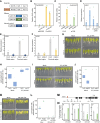ENHANCER OF SHOOT REGENERATION1 promotes de novo root organogenesis after wounding in Arabidopsis leaf explants
- PMID: 38445764
- PMCID: PMC11132873
- DOI: 10.1093/plcell/koae074
ENHANCER OF SHOOT REGENERATION1 promotes de novo root organogenesis after wounding in Arabidopsis leaf explants
Abstract
Plants have an astonishing ability to regenerate new organs after wounding. Here, we report that the wound-inducible transcription factor ENHANCER OF SHOOT REGENERATION1 (ESR1) has a dual mode of action in activating ANTHRANILATE SYNTHASE ALPHA SUBUNIT1 (ASA1) expression to ensure auxin-dependent de novo root organogenesis locally at wound sites of Arabidopsis (Arabidopsis thaliana) leaf explants. In the first mode, ESR1 interacts with HISTONE DEACETYLASE6 (HDA6), and the ESR1-HDA6 complex directly binds to the JASMONATE-ZIM DOMAIN5 (JAZ5) locus, inhibiting JAZ5 expression through histone H3 deacetylation. As JAZ5 interferes with the action of ETHYLENE RESPONSE FACTOR109 (ERF109), the transcriptional repression of JAZ5 at the wound site allows ERF109 to activate ASA1 expression. In the second mode, the ESR1 transcriptional activator directly binds to the ASA1 promoter to enhance its expression. Overall, our findings indicate that the dual biochemical function of ESR1, which specifically occurs near wound sites of leaf explants, maximizes local auxin biosynthesis and de novo root organogenesis in Arabidopsis.
© The Author(s) 2024. Published by Oxford University Press on behalf of American Society of Plant Biologists. All rights reserved. For commercial re-use, please contact reprints@oup.com for reprints and translation rights for reprints. All other permissions can be obtained through our RightsLink service via the Permissions link on the article page on our site—for further information please contact journals.permissions@oup.com.
Conflict of interest statement
Conflict of interest statement. None declared.
Figures







Similar articles
-
ESR2-HDA6 complex negatively regulates auxin biosynthesis to delay callus initiation in Arabidopsis leaf explants during tissue culture.Plant Commun. 2024 Jul 8;5(7):100892. doi: 10.1016/j.xplc.2024.100892. Epub 2024 Apr 2. Plant Commun. 2024. PMID: 38566417 Free PMC article.
-
The epigenetic regulator ULTRAPETALA1 suppresses de novo root regeneration from Arabidopsis leaf explants.Plant Signal Behav. 2022 Dec 31;17(1):2031784. doi: 10.1080/15592324.2022.2031784. Epub 2022 Feb 15. Plant Signal Behav. 2022. PMID: 35164655 Free PMC article.
-
WIND1 Promotes Shoot Regeneration through Transcriptional Activation of ENHANCER OF SHOOT REGENERATION1 in Arabidopsis.Plant Cell. 2017 Jan;29(1):54-69. doi: 10.1105/tpc.16.00623. Epub 2016 Dec 23. Plant Cell. 2017. PMID: 28011694 Free PMC article.
-
The shady side of leaf development: the role of the REVOLUTA/KANADI1 module in leaf patterning and auxin-mediated growth promotion.Curr Opin Plant Biol. 2017 Feb;35:111-116. doi: 10.1016/j.pbi.2016.11.016. Epub 2016 Dec 3. Curr Opin Plant Biol. 2017. PMID: 27918939 Review.
-
Multiple layers of regulators emerge in the network controlling lateral root organogenesis.Trends Plant Sci. 2025 May;30(5):499-514. doi: 10.1016/j.tplants.2024.09.018. Epub 2024 Oct 24. Trends Plant Sci. 2025. PMID: 39455398 Review.
Cited by
-
De novo root regeneration from leaf explant: a mechanistic review of key factors behind cell fate transition.Planta. 2025 Jan 14;261(2):33. doi: 10.1007/s00425-025-04616-1. Planta. 2025. PMID: 39808280 Review.
-
Adventitious Root Formation in Cuttings: Insights from Arabidopsis and Prospects for Woody Plants.Biomolecules. 2025 Jul 28;15(8):1089. doi: 10.3390/biom15081089. Biomolecules. 2025. PMID: 40867534 Free PMC article. Review.
-
Root tip regeneration: Yet another feather in FERONIA's cap.Plant Cell. 2025 Jul 1;37(7):koaf154. doi: 10.1093/plcell/koaf154. Plant Cell. 2025. PMID: 40505095 Free PMC article. No abstract available.
-
The AP2 transcription factor BARE RECEPTACLE regulates floral organogenesis via auxin pathways in woodland strawberry.Plant Cell. 2024 Oct 4;36(12):4970-87. doi: 10.1093/plcell/koae270. Online ahead of print. Plant Cell. 2024. PMID: 39367407
References
-
- Bossi F, Cordoba E, Dupre P, Mendoza MS, Roman CS, Leon P. The Arabidopsis ABA-INSENSITIVE (ABI) 4 factor acts as a central transcription activator of the expression of its own gene, and for the induction of ABI5 and SBE2.2 genes during sugar signaling. Plant J. 2009:59(3):359–374. 10.1111/j.1365-313X.2009.03877.x - DOI - PubMed
MeSH terms
Substances
Grants and funding
LinkOut - more resources
Full Text Sources
Research Materials
Miscellaneous

